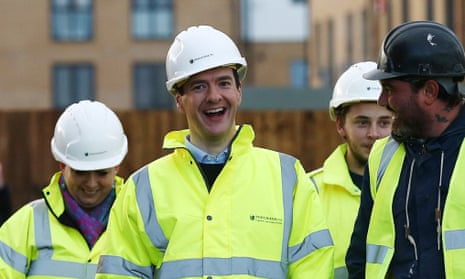Watching George Osborne deliver budgets has all the charm and entertainment value of watching a peculiarly inept children’s entertainer attempt to perform magic tricks. “Employment is up!” George cries. “But wages are down,” replies the audience. “Inequality is lower!” “But wealth inequality has risen!”, comes the reply. The chancellor needs a functioning calculator, a crash course in economics, and to learn that the Office for Budget Responsibility’s (ODR) forecasts are notoriously unreliable.
There were some sleights of hand designed to yield positive headlines that mostly faltered. The hypothecated tax on tampons was quickly decried as insulting given the government’s cuts to women’s services; the tax credits U-turn looked politically weak, and also failed to hide the fact the cuts will come in anyway through universal credit.
But the housing announcements were an utter shambles. Peppering his speech with references to building, Osborne doubled the housing budget to £2bn and pledged to build 400,000 new homes by 2020-21, half of which are to be starter homes, available to first-time buyers at a 20% discount to the market rate. All dandy and to be applauded – if we lived in a universe where market rates for housing weren’t so far removed from local wages. You’d be better off hoping for a win on scratch cards than a stab at owning your own home.
The chancellor claimed he is “fixing the roof when the sun is shining”, when in reality his housing policy is demolishing the house while pointing excitedly at a nearby building site. The core of the housing crisis is not purely supply, but affordability and tenure. Claiming to build 400,000 more “affordable” homes, while stopping your ears when the public points out that 80% of market rate is not affordable because the market has spiralled out of control, is no answer.
But you should always read the small print, whether on insurance policies or economic statements. The OBR’s forecast for growth in average earnings in 2015 was 2.6%, growing a few percentage points each year. The revised statement on Wednesday instead put growth at less than a fifth of that: 0.5%, with wages forecast to fall slightly year-on-year until 2020. House prices, conversely, are set to rise 5% year-on-year. The affordability conundrum is now far more difficult to solve without the real estate bubble bursting.
Some people, however, had reason to celebrate. House builders Taylor Wimpey, Persimmon and Barratt Developments saw stocks rise on the morning of the statement. The fortuitous news that state money was being pumped into this section of the private sector boosted their combined stock market value by £750m. Estate agency Foxtons saw its shares rise by 2.5%.
Even with Osborne’s promise to offer a new help-to-buy scheme for first-time buyers in London with a 5% deposit, a couple earning £41,000 each would need a deposit just shy of £19,000 to afford a home worth £369,000. The average house price in London has now reached £500,000.
So what are we left with? A drive to build homes that few could afford, with the state subsidising the private sector and never recouping that cost. A promise to build 400,000 homes within the next five years, when we need homes built at a rate of 250,000 a year. Nothing at all to tackle the booming homelessness rates amongst households that could never afford to buy a home while the housing market remains dangerously inflated. Cuts to housing benefit for the poorest new tenants, booming house prices, and falling wages.
Osborne and co have quietly been drafting social housing’s obituary. They fail to invest, ramp up right-to-buy discounts and extend the policy to housing association tenants, then force councils to sell their few remaining homes when tenants move out or die.
Now Osborne heralds the “biggest housebuilding programme since the 1970s”, overlooking the fact that those 1970s houses were publicly owned, and paid for themselves within years of being built. The difference is the taxpayer will never recoup the money that is pumped into private development: private builders cream it off, while we pay ever-higher costs for a roof over our heads and our wages remain stagnant. And when, not if, we see a housing crash, it will be left to the government to pick up the pieces.
Sign up for your free Guardian Housing network newsletter with news and analysis sent direct to you every Friday. Follow us: @GuardianHousing

